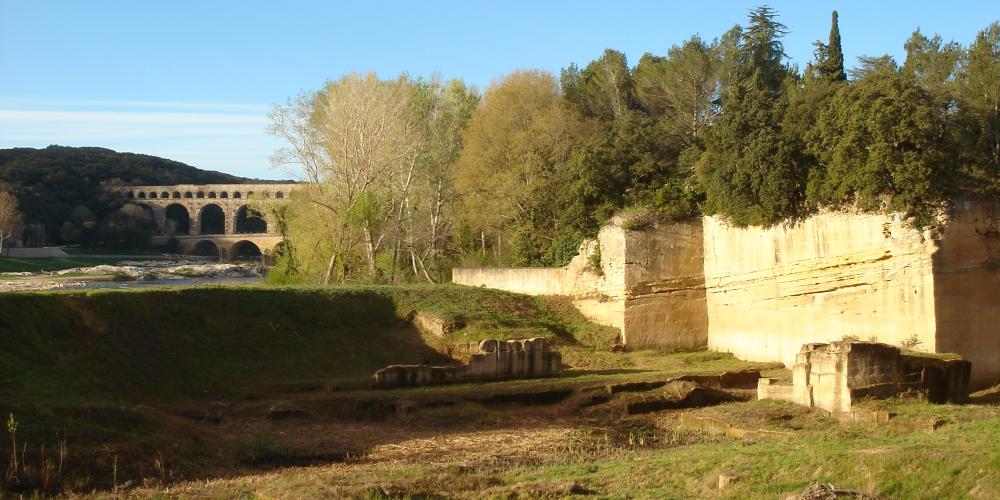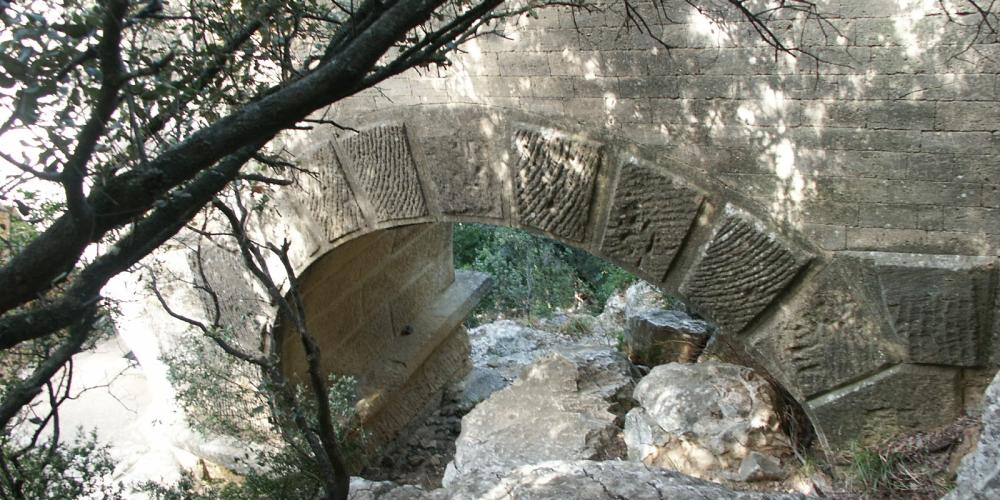Uncovering Pont du Gard's archaeological secrets

**When was your first encounter with the Pont du Gard and what do you remember about it? **
C.P: I've been familiar with the Pont du Gard since I was a child. During the 1960's, my parents took me travelling a lot so I could learn about historic sites. I was around 10 years old when my parents took me to the Pont du Gard. I remember being incredibly impressed by this monument and feeling that I was witnessing an important part of history. It featured in my Year 7 text book, about the Roman era. The sense of astonishment I felt, and my fascination with this period of history, developed into an interest in all ancient civilisations. I studied Latin at secondary school and from then on, I knew I wanted to be an archaeologist.
In 1992, fate brought me back to the Pont du Gard when I was hired by Gard Department Council as an archaeologist, as part of the site's first development project. My job was to select items to display in the future Musée du Pont du Gard museum.
You are part of a panel of experts responsible for developing the body of knowledge about the monument currently presented to visitors at the Pont du Gard museum. As an archaeologist, what's been your contribution?
C.P: I first joined the Committee of Scientific Experts in 1988 when Guy Barruol was chair, then in 1996 Jean Luc Fiches, Director of the CNRS (national centre for scientific research), became chair. The Committee was a tightly knit team of around twenty scientists with multi-disciplinary skills, working together to develop a "Scientific and Cultural Programme" which formed the basis for the design of the future Interpretation and Development Centre (today's Museum). Archaeologists, architects specialising in ancient buildings, surveying engineers, historians, geographers, geologists, hydrologists, sedimentologists, image interpreters, cartographers etc. assembled more than 50 documents, with each contributing his or her own expertise. Because I could read publications in German, Italian and Spanish, I worked on compiling a document, collating knowledge about major Roman aqueducts - in Cologne, Rome, Lyon, Carthage, Segovia, Tarragon etc. - that existed at the height of the Roman civilisation.
The team of museum specialists, supervised by Thomas Bourgneuf, drew on all these contributions to design a large, multimedia centre and establish a trail to help visitors understand how the old aqueduct and the Pont du Gard were built and worked, and learn about the Roman civilisation that created them.
What do we know about the Pont du Gard today that we didn't know
previously?
C.P: The Pont du Gard was known to the public because of its high-profile reputation but less was known about its history. We wanted to gain more detailed knowledge about the entire aqueduct system which, obviously, included an assessment of the Pont du Gard.
The key development relates to the dating of the monument: archaeological excavations carried out from 1984 onwards revealed that the aqueduct had been built at around 50 BCE. and not in 19 BCE according to the traditional theory.
The investigations also allowed us to take a closer look at the architecture of the aqueduct bridge. A 60 cm elevated section of channel was revealed and a regulation basin was also uncovered at the bridge head. The inscription " mens totum corium" was deciphered, meaning: the entirety of the work has been measured. Perhaps this was a message left by the architect whose name is still unknown today.
We were also able to examine the Roman quarry located 600 meters downstream from the bridge. The quarry face was still identifiable and the imprint of blocks of stone, extracted by quarry workers using picks or metal coins, was also visible. Approximately 120,000 m3 of hewn stone was extracted from the site.
We also uncovered another new findings when we analysed the red coating covering the channel walls. According to Vitruve, this coating was made from cow's blood and fig sap. Chemical analysis revealed a completely different composition: red sand (containing iron oxide) mixed with lime (lime slurry).
Later, after the terrible floods in 2002 when the the river Gardon overflowed, river banks were swept away revealing traces of Roman hoisting devices. Studying these devices helped us visualise the organisation of the construction site and better understand how these enormous blocks of stone had been lifted.
Today, all these elements are on display at the beautiful Pont du Gard museum.
**After the Roman era, what were the critical junctures for this building? **
C.P: The Pont du Gard aqueduct transported clean water (35 000 m3 per day), well into the 3rd century. Unfortunately, a critical juncture occurred during the 4th century when they aqueduct was no longer maintained. A study of conduit wall concretion showed that the water transported by the aqueduct had been muddy, soil-laden water and unsafe to drink. The aqueduct as a whole, and the Pont du Gard in particular, were allowed to fall into disrepair around the beginning of the 6 th century.
During the Middle Ages, the Pont was then used as a quarry and, as a result of this looting, lost 12 of the arches on the 3rd tier. During the Renaissance, it was used as a bridge for road traffic without any consideration given to the potential risks involved. All the mid-level piers were hollowed out to allow pedestrians, riders, carts and even troops, at times of war, to pass through. It could have collapsed!
But it's also worth noting that this constant use, over the centuries, probably helped save it. Between 1699 and 1702, architects Laurens and d'Aviler undertook work to strengthen the arches by consolidating the piers and adding corbels.
A road bridge was built in 1746, adjoining the first level of the Roman bridge: and visitors still walk on this today.
Its inclusion on the first list of historic monuments by Prosper Mérimée in 1840 saved it once and for all, and marked the start of a defining and altogether happier period, focusing on conservation and restoration.
In the mid 19th century, two significant restoration campaigns were carried out by architects Questel and Laisné.
Another restoration campaign was carried out between 1992 and 2005. These works focused on the three tiers of the Roman bridge and mostly involved major maintenance. It has provided the bridge with a new lease of life for the next hundred or so years.
This bridge is considered exceptional throughout the world; what is it that makes it such a remarkable monument?
C.P: It's unusual in terms of its dimensions and state of conservation. It's the tallest, preserved Roman aqueduct-bridge. UNESCO included it on the List of World Heritage Sites because it met three criteria: it is a masterpiece of human creative genius, it provides unique evidence of Roman civilisation and is an outstanding example of a particular type of construction. Its construction required pioneering technological prowess. It's the highest three-tier bridge in existence and the principal arch has an opening of 25 metres, which required the construction of "centring" timber scaffolding, of an unprecedented scale. And all of this was achieved without a computer, calculator or machinery! The aqueduct's gradient is also a significant feat of engineering: it slopes an average of 24 cm per km! At that time, this was one of the shallowest gradients ever achieved, extending over a distance of 50 km.
Its incredible state of conservation also makes it a unique monument. It has withstood the onslaught of raging rivers, earthquakes, wars and is pretty much intact today.
How long has it been considered a masterpiece and when did it become so popular?
C.P: The Pont du Gard was considered a remarkable monument from the 16th century onwards. It became a landmark and was visited by many learned travellers. Then, the 18th century saw the birth of Romanticism and a fascination for the poetic nature of ruins. The writer Jean Jacques Rousseau was awe-struck at the sight of the Pont du Gard and subsequently declared "Why was I not born Roman!"
The Pont became really popular during the late 19th century. Engravings show visitors standing under the arches or walking along the third tier. Many parties were held there. In 1865, an inn was built on the site which was replaced in 1901 by a café-restaurant.
With the arrival of paid holidays, the site experienced an increased number of visitors, giving rise to mass tourism from the 1960's onwards. The inclusion of the Pont du Gard on the List of World Heritage Sites in 1985 made the public authorities realise (the State and local and regional authorities) that it was essential to control tourist numbers in order to preserve the majestic and unspoiled nature of the site.
How do you protect a site that is visited by so many people today?
C.P: As part of the site's redevelopment initiative in 2000, the area surrounding the Pont was reorganised and redesigned so as to provide visiting conditions commensurate with the reputation enjoyed - both nationally and internationally - by the Pont du Gard site.
Today, within the 165 ha natural setting, there are three areas that help protect the monument: a public area with visitor reception, public services and museums; a discovery area, with more restricted access, comprising the "Mémoires de garrigue" outdoor museum trail with marked paths that flank the remains of the Roman aqueduct; and finally, a protected zone, comprising forested areas, where public entry is not encouraged.
In 2004, thanks to the site's sound environmental management and visitor reception areas, the Pont du Gard was awarded the "Grand site de France" label, a distinction bestowed by the Ministry of the Environment and Sustainable Development.



